Business Decision Making: An Essay for BA Business - Suffolk Uni
VerifiedAdded on 2023/06/16
|7
|1301
|153
Essay
AI Summary
This essay provides an analysis of business decision-making, focusing on financial analysis techniques such as Net Present Value (NPV) and payback period. It examines two projects, A (Vegan chocolates) and B (vegan spread), evaluating their potential returns on investment. The essay compares and contrasts the payback period and NPV methods, highlighting their implications for stakeholders. It also considers both financial and non-financial factors influencing decision-making, such as debt paying capacity, interest rates, emergency funds, and regulatory compliance. The conclusion emphasizes the importance of calculating returns on investment to mitigate risks before committing to projects.

BUSINESS DECISION
MAKING
MAKING
Paraphrase This Document
Need a fresh take? Get an instant paraphrase of this document with our AI Paraphraser
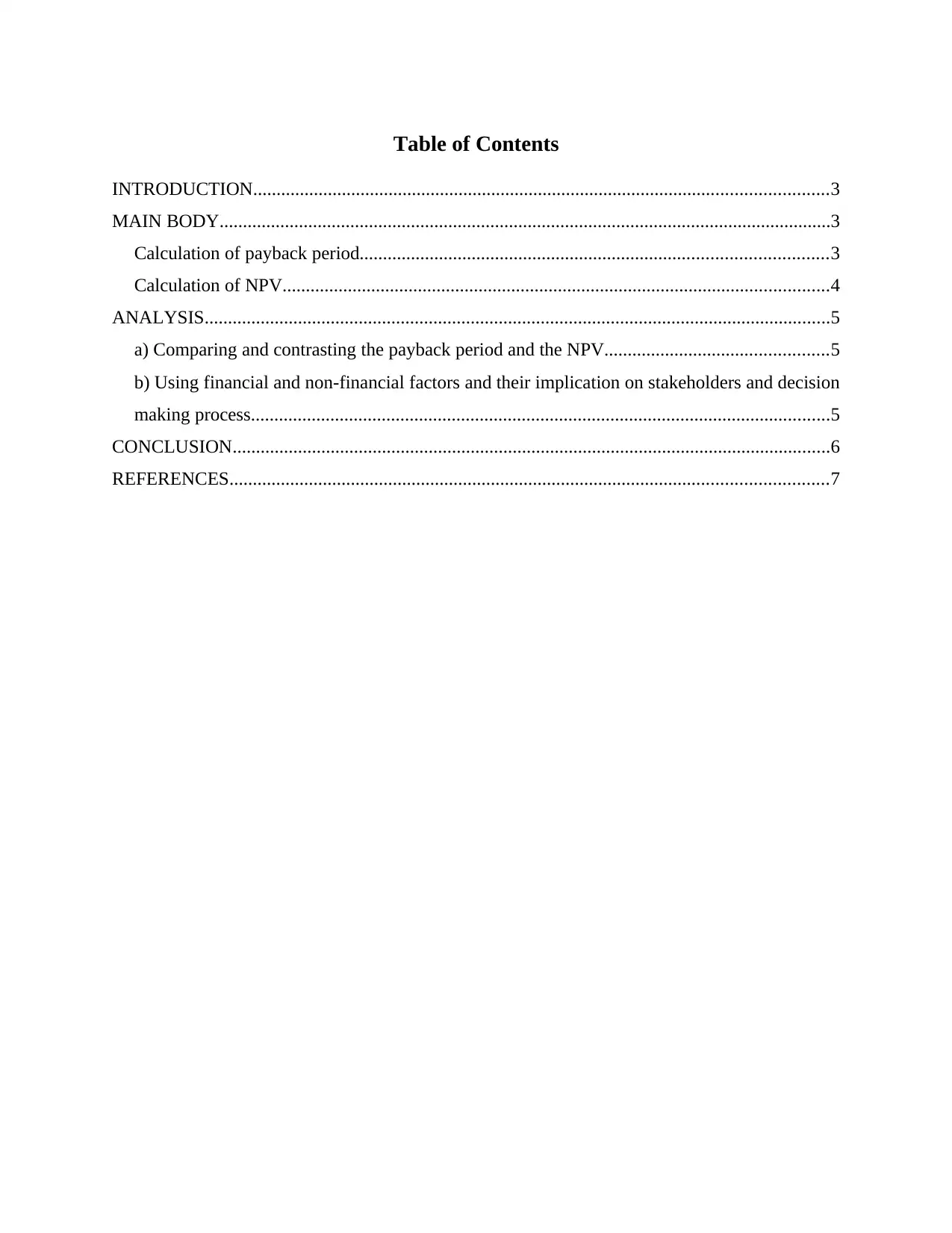
Table of Contents
INTRODUCTION...........................................................................................................................3
MAIN BODY...................................................................................................................................3
Calculation of payback period....................................................................................................3
Calculation of NPV.....................................................................................................................4
ANALYSIS......................................................................................................................................5
a) Comparing and contrasting the payback period and the NPV................................................5
b) Using financial and non-financial factors and their implication on stakeholders and decision
making process............................................................................................................................5
CONCLUSION................................................................................................................................6
REFERENCES................................................................................................................................7
INTRODUCTION...........................................................................................................................3
MAIN BODY...................................................................................................................................3
Calculation of payback period....................................................................................................3
Calculation of NPV.....................................................................................................................4
ANALYSIS......................................................................................................................................5
a) Comparing and contrasting the payback period and the NPV................................................5
b) Using financial and non-financial factors and their implication on stakeholders and decision
making process............................................................................................................................5
CONCLUSION................................................................................................................................6
REFERENCES................................................................................................................................7
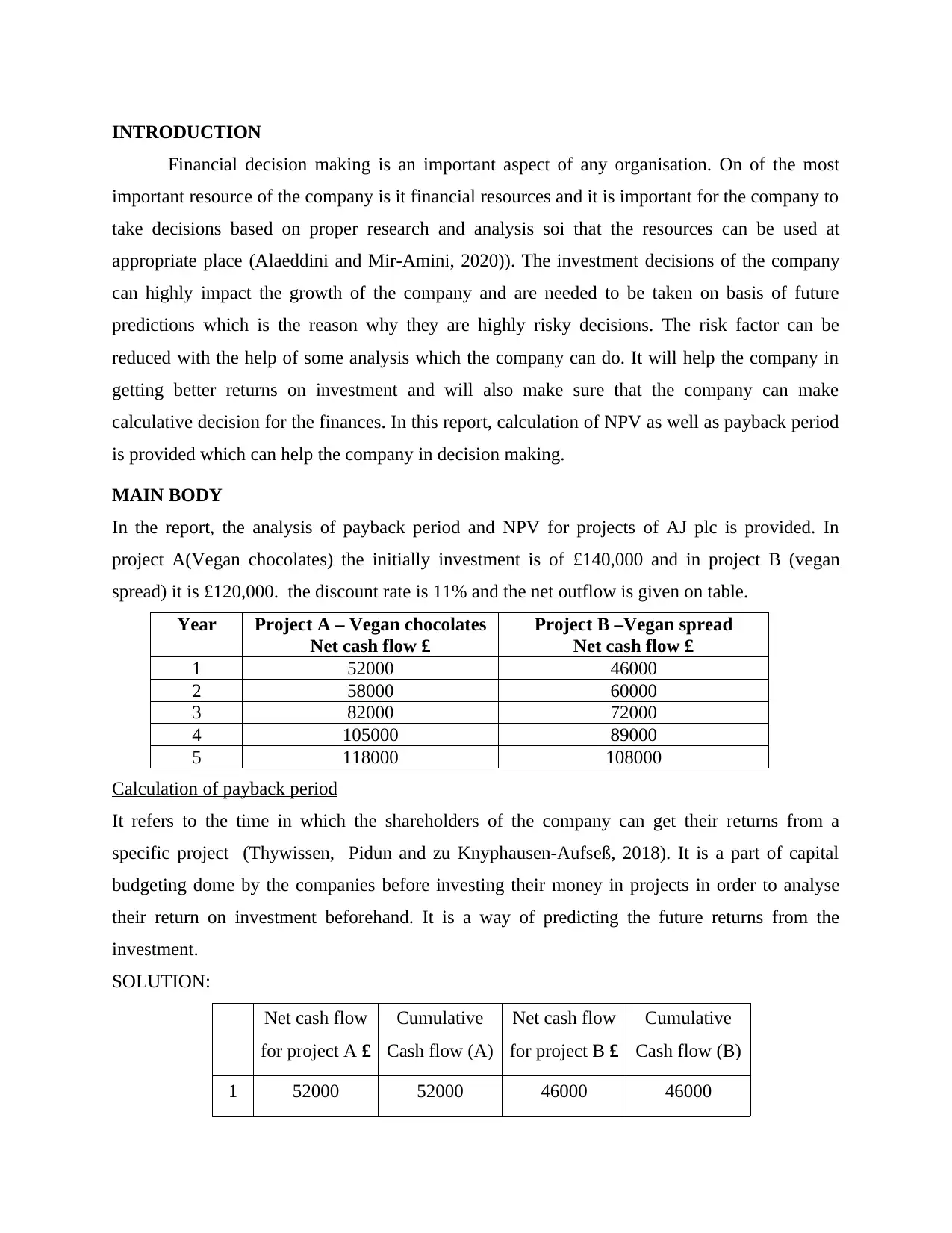
INTRODUCTION
Financial decision making is an important aspect of any organisation. On of the most
important resource of the company is it financial resources and it is important for the company to
take decisions based on proper research and analysis soi that the resources can be used at
appropriate place (Alaeddini and Mir-Amini, 2020)). The investment decisions of the company
can highly impact the growth of the company and are needed to be taken on basis of future
predictions which is the reason why they are highly risky decisions. The risk factor can be
reduced with the help of some analysis which the company can do. It will help the company in
getting better returns on investment and will also make sure that the company can make
calculative decision for the finances. In this report, calculation of NPV as well as payback period
is provided which can help the company in decision making.
MAIN BODY
In the report, the analysis of payback period and NPV for projects of AJ plc is provided. In
project A(Vegan chocolates) the initially investment is of £140,000 and in project B (vegan
spread) it is £120,000. the discount rate is 11% and the net outflow is given on table.
Year Project A – Vegan chocolates
Net cash flow £
Project B –Vegan spread
Net cash flow £
1 52000 46000
2 58000 60000
3 82000 72000
4 105000 89000
5 118000 108000
Calculation of payback period
It refers to the time in which the shareholders of the company can get their returns from a
specific project (Thywissen, Pidun and zu Knyphausen-Aufseß, 2018). It is a part of capital
budgeting dome by the companies before investing their money in projects in order to analyse
their return on investment beforehand. It is a way of predicting the future returns from the
investment.
SOLUTION:
Net cash flow
for project A £
Cumulative
Cash flow (A)
Net cash flow
for project B £
Cumulative
Cash flow (B)
1 52000 52000 46000 46000
Financial decision making is an important aspect of any organisation. On of the most
important resource of the company is it financial resources and it is important for the company to
take decisions based on proper research and analysis soi that the resources can be used at
appropriate place (Alaeddini and Mir-Amini, 2020)). The investment decisions of the company
can highly impact the growth of the company and are needed to be taken on basis of future
predictions which is the reason why they are highly risky decisions. The risk factor can be
reduced with the help of some analysis which the company can do. It will help the company in
getting better returns on investment and will also make sure that the company can make
calculative decision for the finances. In this report, calculation of NPV as well as payback period
is provided which can help the company in decision making.
MAIN BODY
In the report, the analysis of payback period and NPV for projects of AJ plc is provided. In
project A(Vegan chocolates) the initially investment is of £140,000 and in project B (vegan
spread) it is £120,000. the discount rate is 11% and the net outflow is given on table.
Year Project A – Vegan chocolates
Net cash flow £
Project B –Vegan spread
Net cash flow £
1 52000 46000
2 58000 60000
3 82000 72000
4 105000 89000
5 118000 108000
Calculation of payback period
It refers to the time in which the shareholders of the company can get their returns from a
specific project (Thywissen, Pidun and zu Knyphausen-Aufseß, 2018). It is a part of capital
budgeting dome by the companies before investing their money in projects in order to analyse
their return on investment beforehand. It is a way of predicting the future returns from the
investment.
SOLUTION:
Net cash flow
for project A £
Cumulative
Cash flow (A)
Net cash flow
for project B £
Cumulative
Cash flow (B)
1 52000 52000 46000 46000
⊘ This is a preview!⊘
Do you want full access?
Subscribe today to unlock all pages.

Trusted by 1+ million students worldwide
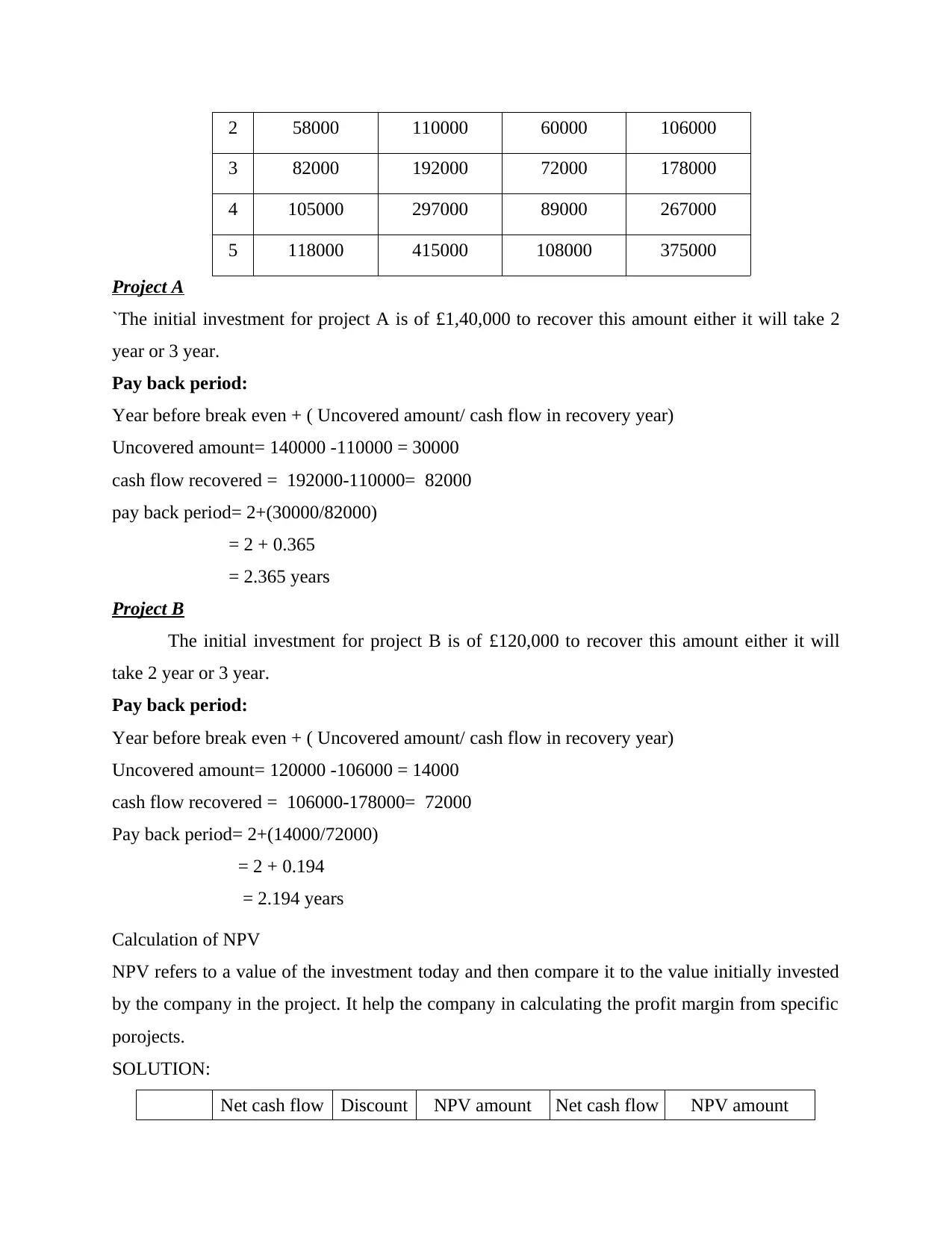
2 58000 110000 60000 106000
3 82000 192000 72000 178000
4 105000 297000 89000 267000
5 118000 415000 108000 375000
Project A
`The initial investment for project A is of £1,40,000 to recover this amount either it will take 2
year or 3 year.
Pay back period:
Year before break even + ( Uncovered amount/ cash flow in recovery year)
Uncovered amount= 140000 -110000 = 30000
cash flow recovered = 192000-110000= 82000
pay back period= 2+(30000/82000)
= 2 + 0.365
= 2.365 years
Project B
The initial investment for project B is of £120,000 to recover this amount either it will
take 2 year or 3 year.
Pay back period:
Year before break even + ( Uncovered amount/ cash flow in recovery year)
Uncovered amount= 120000 -106000 = 14000
cash flow recovered = 106000-178000= 72000
Pay back period= 2+(14000/72000)
= 2 + 0.194
= 2.194 years
Calculation of NPV
NPV refers to a value of the investment today and then compare it to the value initially invested
by the company in the project. It help the company in calculating the profit margin from specific
porojects.
SOLUTION:
Net cash flow Discount NPV amount Net cash flow NPV amount
3 82000 192000 72000 178000
4 105000 297000 89000 267000
5 118000 415000 108000 375000
Project A
`The initial investment for project A is of £1,40,000 to recover this amount either it will take 2
year or 3 year.
Pay back period:
Year before break even + ( Uncovered amount/ cash flow in recovery year)
Uncovered amount= 140000 -110000 = 30000
cash flow recovered = 192000-110000= 82000
pay back period= 2+(30000/82000)
= 2 + 0.365
= 2.365 years
Project B
The initial investment for project B is of £120,000 to recover this amount either it will
take 2 year or 3 year.
Pay back period:
Year before break even + ( Uncovered amount/ cash flow in recovery year)
Uncovered amount= 120000 -106000 = 14000
cash flow recovered = 106000-178000= 72000
Pay back period= 2+(14000/72000)
= 2 + 0.194
= 2.194 years
Calculation of NPV
NPV refers to a value of the investment today and then compare it to the value initially invested
by the company in the project. It help the company in calculating the profit margin from specific
porojects.
SOLUTION:
Net cash flow Discount NPV amount Net cash flow NPV amount
Paraphrase This Document
Need a fresh take? Get an instant paraphrase of this document with our AI Paraphraser
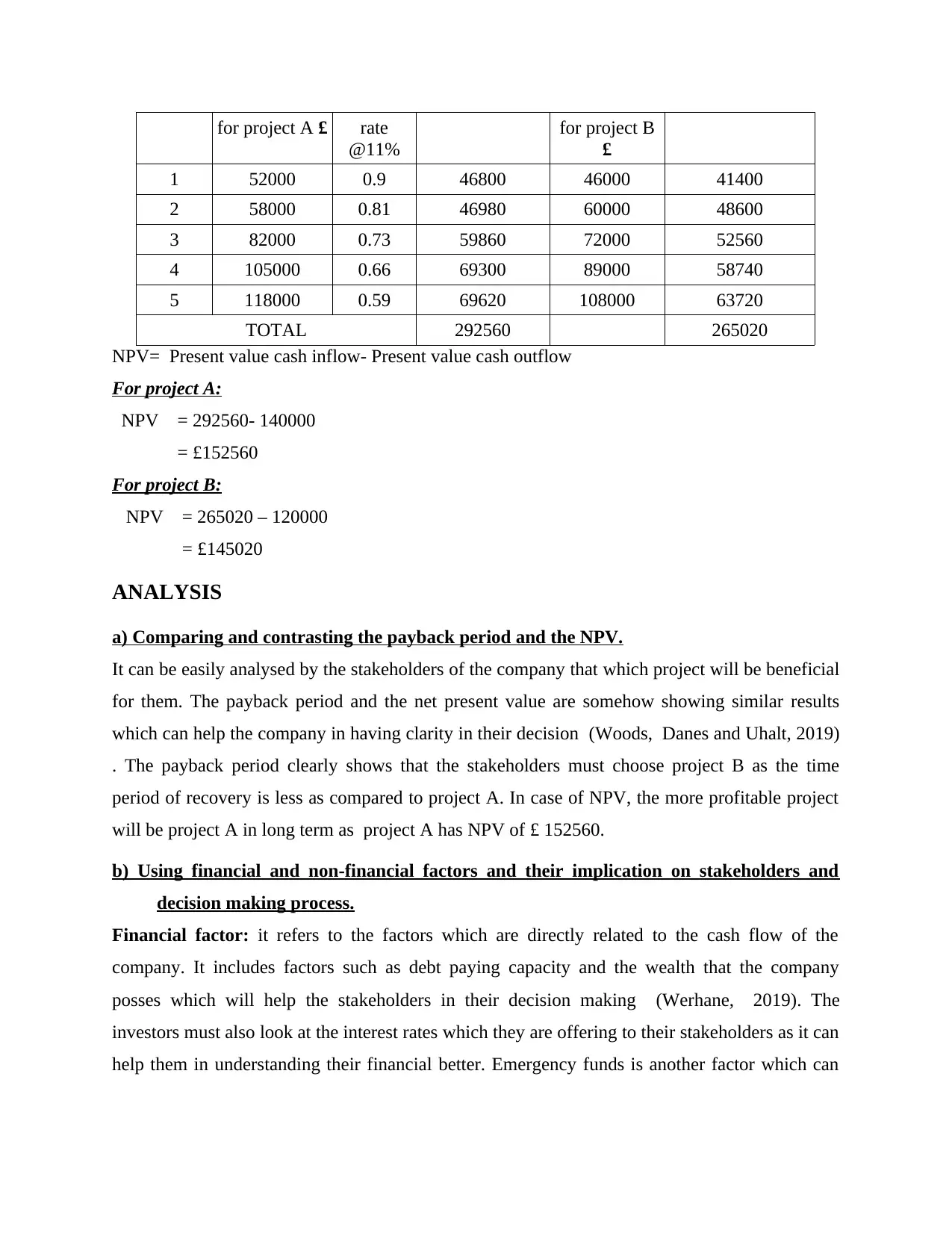
for project A £ rate
@11%
for project B
£
1 52000 0.9 46800 46000 41400
2 58000 0.81 46980 60000 48600
3 82000 0.73 59860 72000 52560
4 105000 0.66 69300 89000 58740
5 118000 0.59 69620 108000 63720
TOTAL 292560 265020
NPV= Present value cash inflow- Present value cash outflow
For project A:
NPV = 292560- 140000
= £152560
For project B:
NPV = 265020 – 120000
= £145020
ANALYSIS
a) Comparing and contrasting the payback period and the NPV.
It can be easily analysed by the stakeholders of the company that which project will be beneficial
for them. The payback period and the net present value are somehow showing similar results
which can help the company in having clarity in their decision (Woods, Danes and Uhalt, 2019)
. The payback period clearly shows that the stakeholders must choose project B as the time
period of recovery is less as compared to project A. In case of NPV, the more profitable project
will be project A in long term as project A has NPV of £ 152560.
b) Using financial and non-financial factors and their implication on stakeholders and
decision making process.
Financial factor: it refers to the factors which are directly related to the cash flow of the
company. It includes factors such as debt paying capacity and the wealth that the company
posses which will help the stakeholders in their decision making (Werhane, 2019). The
investors must also look at the interest rates which they are offering to their stakeholders as it can
help them in understanding their financial better. Emergency funds is another factor which can
@11%
for project B
£
1 52000 0.9 46800 46000 41400
2 58000 0.81 46980 60000 48600
3 82000 0.73 59860 72000 52560
4 105000 0.66 69300 89000 58740
5 118000 0.59 69620 108000 63720
TOTAL 292560 265020
NPV= Present value cash inflow- Present value cash outflow
For project A:
NPV = 292560- 140000
= £152560
For project B:
NPV = 265020 – 120000
= £145020
ANALYSIS
a) Comparing and contrasting the payback period and the NPV.
It can be easily analysed by the stakeholders of the company that which project will be beneficial
for them. The payback period and the net present value are somehow showing similar results
which can help the company in having clarity in their decision (Woods, Danes and Uhalt, 2019)
. The payback period clearly shows that the stakeholders must choose project B as the time
period of recovery is less as compared to project A. In case of NPV, the more profitable project
will be project A in long term as project A has NPV of £ 152560.
b) Using financial and non-financial factors and their implication on stakeholders and
decision making process.
Financial factor: it refers to the factors which are directly related to the cash flow of the
company. It includes factors such as debt paying capacity and the wealth that the company
posses which will help the stakeholders in their decision making (Werhane, 2019). The
investors must also look at the interest rates which they are offering to their stakeholders as it can
help them in understanding their financial better. Emergency funds is another factor which can
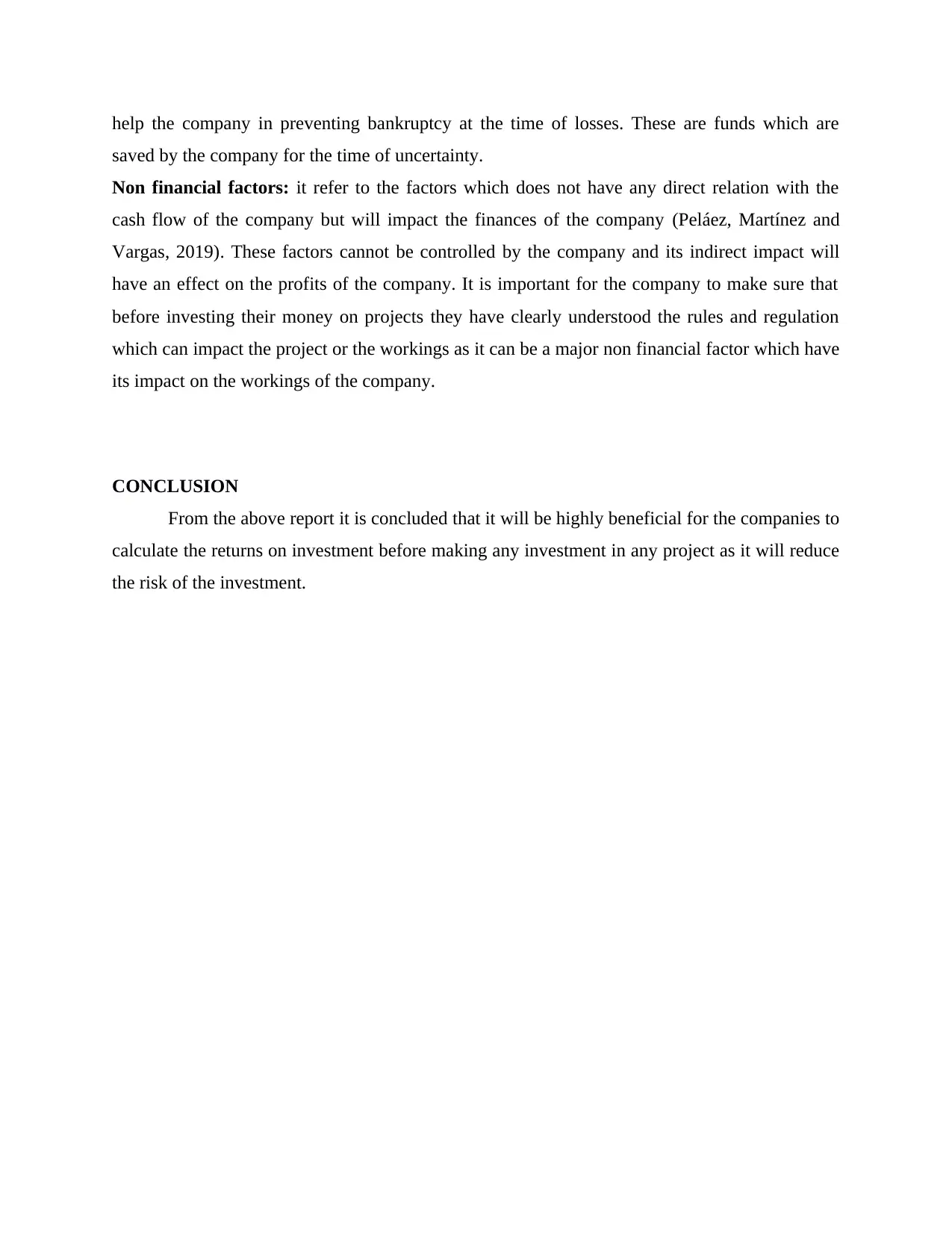
help the company in preventing bankruptcy at the time of losses. These are funds which are
saved by the company for the time of uncertainty.
Non financial factors: it refer to the factors which does not have any direct relation with the
cash flow of the company but will impact the finances of the company (Peláez, Martínez and
Vargas, 2019). These factors cannot be controlled by the company and its indirect impact will
have an effect on the profits of the company. It is important for the company to make sure that
before investing their money on projects they have clearly understood the rules and regulation
which can impact the project or the workings as it can be a major non financial factor which have
its impact on the workings of the company.
CONCLUSION
From the above report it is concluded that it will be highly beneficial for the companies to
calculate the returns on investment before making any investment in any project as it will reduce
the risk of the investment.
saved by the company for the time of uncertainty.
Non financial factors: it refer to the factors which does not have any direct relation with the
cash flow of the company but will impact the finances of the company (Peláez, Martínez and
Vargas, 2019). These factors cannot be controlled by the company and its indirect impact will
have an effect on the profits of the company. It is important for the company to make sure that
before investing their money on projects they have clearly understood the rules and regulation
which can impact the project or the workings as it can be a major non financial factor which have
its impact on the workings of the company.
CONCLUSION
From the above report it is concluded that it will be highly beneficial for the companies to
calculate the returns on investment before making any investment in any project as it will reduce
the risk of the investment.
⊘ This is a preview!⊘
Do you want full access?
Subscribe today to unlock all pages.

Trusted by 1+ million students worldwide
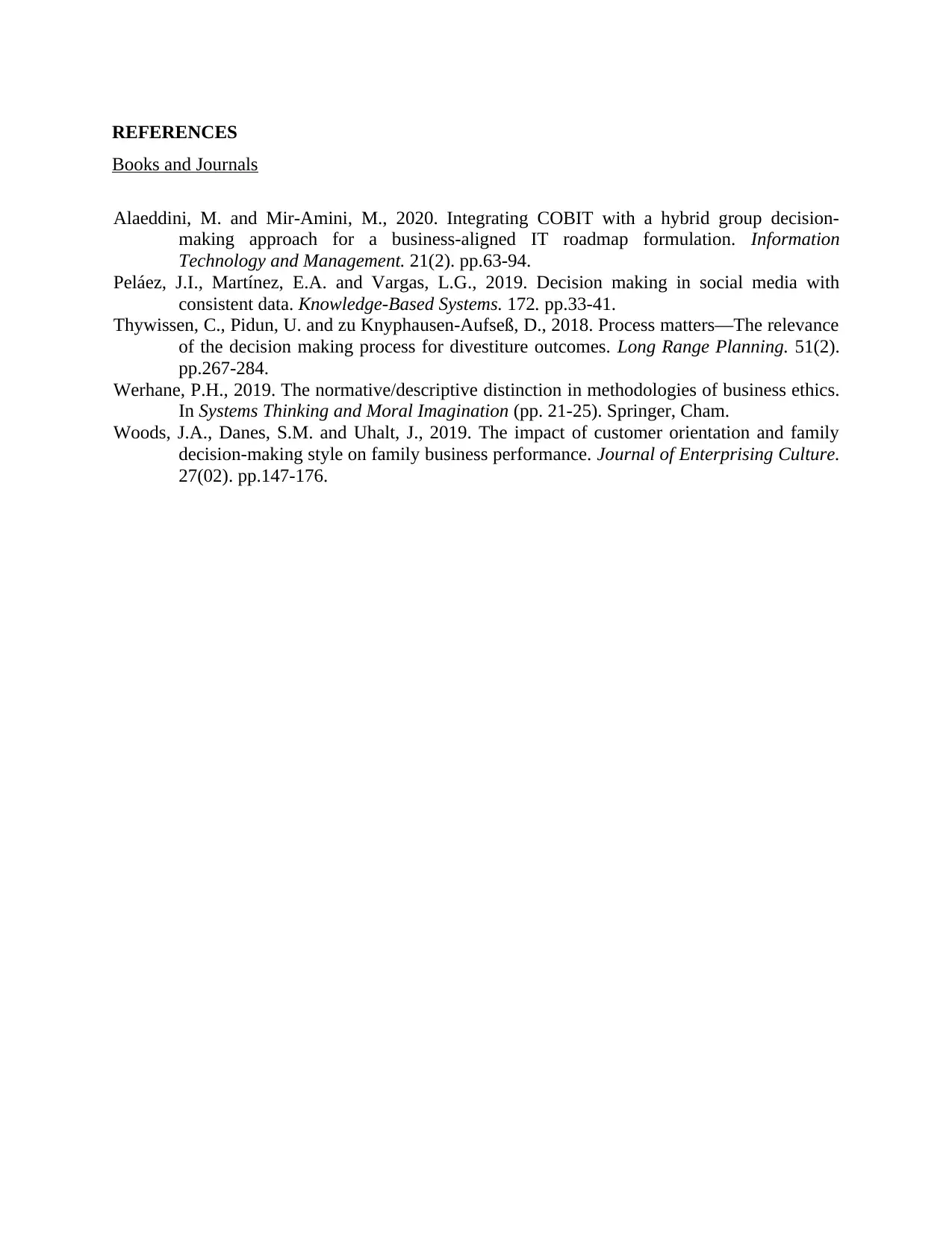
REFERENCES
Books and Journals
Alaeddini, M. and Mir-Amini, M., 2020. Integrating COBIT with a hybrid group decision-
making approach for a business-aligned IT roadmap formulation. Information
Technology and Management. 21(2). pp.63-94.
Peláez, J.I., Martínez, E.A. and Vargas, L.G., 2019. Decision making in social media with
consistent data. Knowledge-Based Systems. 172. pp.33-41.
Thywissen, C., Pidun, U. and zu Knyphausen-Aufseß, D., 2018. Process matters—The relevance
of the decision making process for divestiture outcomes. Long Range Planning. 51(2).
pp.267-284.
Werhane, P.H., 2019. The normative/descriptive distinction in methodologies of business ethics.
In Systems Thinking and Moral Imagination (pp. 21-25). Springer, Cham.
Woods, J.A., Danes, S.M. and Uhalt, J., 2019. The impact of customer orientation and family
decision-making style on family business performance. Journal of Enterprising Culture.
27(02). pp.147-176.
Books and Journals
Alaeddini, M. and Mir-Amini, M., 2020. Integrating COBIT with a hybrid group decision-
making approach for a business-aligned IT roadmap formulation. Information
Technology and Management. 21(2). pp.63-94.
Peláez, J.I., Martínez, E.A. and Vargas, L.G., 2019. Decision making in social media with
consistent data. Knowledge-Based Systems. 172. pp.33-41.
Thywissen, C., Pidun, U. and zu Knyphausen-Aufseß, D., 2018. Process matters—The relevance
of the decision making process for divestiture outcomes. Long Range Planning. 51(2).
pp.267-284.
Werhane, P.H., 2019. The normative/descriptive distinction in methodologies of business ethics.
In Systems Thinking and Moral Imagination (pp. 21-25). Springer, Cham.
Woods, J.A., Danes, S.M. and Uhalt, J., 2019. The impact of customer orientation and family
decision-making style on family business performance. Journal of Enterprising Culture.
27(02). pp.147-176.
1 out of 7
Related Documents
Your All-in-One AI-Powered Toolkit for Academic Success.
+13062052269
info@desklib.com
Available 24*7 on WhatsApp / Email
![[object Object]](/_next/static/media/star-bottom.7253800d.svg)
Unlock your academic potential
Copyright © 2020–2025 A2Z Services. All Rights Reserved. Developed and managed by ZUCOL.


